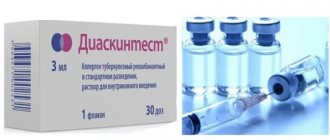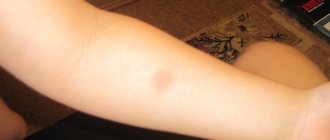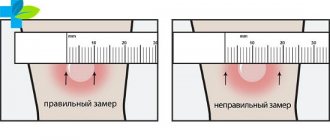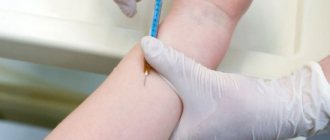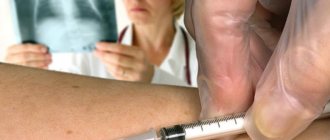The Mantoux test is not a vaccination, as many people believe. This is an allergy test based on the assessment of the reaction to the intradermal injection of two units of tuberculin (a lysate of protein-derived antigens obtained by extraction from heat-treated Mycobacterium tuberculosis). The composition does not include living microorganisms; it is not capable of affecting either the immune system of the subject or his body as a whole. The modern version of tuberculin, in addition to the extract from the causative agent of the disease, contains salts of a phosphate buffer solution, sodium chloride, Tween-80 (stabilizer), phenol (preservative).
0.1 milliliter of solution is injected into the forearm - this is a safe amount of the drug for a person, both for healthy people and for those suffering from somatic diseases. The main purpose of the test is to identify immunity against tuberculosis, assess the degree of its intensity or record its absence. As with any diagnostic injection procedure, there are recommendations and limitations for performing the Mantoux test. Is it permissible to perform Mantoux at a temperature and why? More on this below.
Mantoux test: why is it performed?
The tuberculin test has been used for more than a hundred years, making it possible to diagnose tuberculosis with maximum accuracy. Back in 1908, French researcher Charles Mantoux proposed a drug whose main component was inactivated mycobacterium tuberculosis. Initially it was intended to use tuberculin as a medicine. However, over time it became clear: its therapeutic properties were reduced to zero. But despite this, the drug still gained worldwide fame and almost universal use. Due to its characteristics, tuberculin is of great practical importance in diagnosing tuberculosis.
As scientists managed to find out, the body of a healthy person and a person with tuberculosis reacts differently to the subcutaneous injection of tuberculin. The body's response may be completely absent or pronounced, especially in the presence of latent forms of tuberculosis.
The Mantoux test can be performed:
- massively;
- individually.
Mass diagnostics are carried out mainly for children and adolescents, annually, starting from 12 months. Those babies who for some reason did not receive the BCG vaccination (vaccination against tuberculosis) after birth undergo Mantoux twice a year, starting from 6 months.
Since children are more vulnerable than adults to the negative consequences of tuberculosis, timely diagnosis helps to achieve a favorable prognosis with the right treatment regimen.
Individual diagnostics are used in most cases in TB dispensaries, along with other diagnostic methods to make an accurate and definitive diagnosis.
How long after stabilization of the condition can Mantoux be done?
Different patients may need different recovery times. A therapist or pediatrician who has supervised the treatment of a cold will be able to more accurately indicate the date after which it is allowed to carry out tuberculin diagnostics in a child or adult, taking into account the specifics of the disease and the individual characteristics of the patient. In any case, this can only be discussed after complete recovery. The Mantoux test and a cold are incompatible; against the background of a respiratory disease, the test almost always gives distorted results.
Most often we are talking about the following periods after recovery:
- runny nose – up to two weeks;
- colds – from two to four weeks;
- ARVI - month.
If a quarantine was imposed due to the disease, testing is allowed a month after it is lifted.
Immediately before the appointed date of the test, you must carefully monitor your health and not put unnecessary stress on your immune system in order to get the most correct result. At the same time, you should not be afraid of getting sick again - the test itself does not weaken the body and does not provoke inflammatory processes in it.
On the need for a mass production of Mantoux
The modern legislative framework for healthcare contains a number of documents regulating the implementation of regular preventive measures to prevent tuberculosis. They clearly outline not only the goals and objectives, but also the technique and recommendations for interpreting the results of mass tuberculin diagnostics.
Thus, the annual production of Mantoux helps children and adolescents:
- diagnose tuberculosis in the early stages;
- identify people at increased risk of developing tuberculosis;
- select those who need repeated BCG vaccination.
Mass-conducted tuberculin diagnostics is an important diagnostic method that helps establish the susceptibility of the immune system to tuberculosis pathogens. With the right approach, such prevention can annually reach up to 95% of the child and adolescent population in the area.
Since current data indicate the absence of pronounced symptoms of tuberculosis in the initial stages, this makes its timely diagnosis difficult. However, an allergy test with tuberculin allows you to notice the minor changes that Mycobacterium tuberculosis causes when it enters the body.
What types of cough are there?
There are two opposite types of cough: dry
and
wet
. A dry cough is usually accompanied by a sore throat, pain in the chest, does not bring relief, and can be prolonged. A wet cough, otherwise productive, on the contrary helps to evacuate mucus from the bronchi and is easier to tolerate. In this case, it is important to pay attention to the nature, color, smell, amount of sputum, and the time of its maximum discharge.
Some diseases are characterized only by a dry cough. These are laryngitis, dry pleurisy, compression of the bronchus from the outside (by an enlarged lymph node, tumor). Others, such as bronchitis, tuberculosis, and lung cancer, can initially cause a dry cough, which later turns into a wet cough. In pneumonia, cough is not a mandatory symptom, since the parenchymal tissue of the lungs is devoid of cough receptors.
Timbre
and
the loudness
of the cough differ significantly depending on the cause. A loud, “barking” cough will be observed with swelling of the larynx, compression of the trachea, or psychogenic cough. A barking cough is a classic symptom of whooping cough.
Inflammation of the vocal cords makes the cough loud and harsh. A quiet, short cough, coughing is possible in the presence of a small amount of discharge in the larynx, trachea, with dry pleurisy, the initial stage of pulmonary tuberculosis.
periodic periods are distinguished
and
a constant
cough. Periodic cough usually occurs with colds (ARI), bronchitis, is possible with pneumonia, focal tuberculosis and is represented by single cough impulses. In this case, it can be either short-term, mild, in the form of coughing, or strong, paroxysmal, up to the occurrence of vomiting. With more severe pathologies (severe inflammation of the larynx, trachea, bronchi, high stages of cancer and pulmonary tuberculosis), the cough becomes permanent.
When you can’t perform Mantoux: contraindications
During preventive vaccination, elevated temperature and illness are good reasons for prescribing medical withdrawal. However, it is important to consider that the Mantoux test does not apply to vaccinations. But to obtain a reliable result, all conditions must be observed during its implementation.
As a rule, before performing the Mantoux test, the child must be examined by a local pediatrician. And as a result, he either gives access to the diagnostic procedure or reschedules the visit to the treatment room for a more favorable time. But sometimes it happens that a child shows signs of illness (runny nose, cough, low-grade fever of 37 ° C), and the pediatrician still insists on doing an allergy test. How to be in this case?
First of all, you need to know that an allergy test with tuberculin cannot be performed if you have:
- diseases in acute and chronic form (including epilepsy, bronchial asthma, rheumatism);
- common skin diseases;
- allergic conditions.
Mass tuberculin diagnostics are not carried out if a child care institution (kindergarten, school) is closed for quarantine.
The Mantoux test is done three to four weeks after recovery, when the clinical manifestations of the disease disappear or immediately after quarantine is lifted. In addition, when inserting a “button”, it is recommended to maintain an interval of one month before or after mandatory preventive vaccinations.
This is due to the fact that a weakened body may react differently to the administration of tuberculin. Because of this, the result may be unreliable, which will lead to the appointment of an unnecessary number of examinations and enhanced diagnostics.
According to pediatricians and phthisiatricians, Mantoux does not cause harm to the child’s health. Infection with tuberculosis with the introduction of tuberculin is excluded. And the harmful effects of preservatives and stabilizers contained in the drug cannot have a toxic effect due to the minimum concentration.
When is Mantoux vaccination contraindicated?
Mantua is a subcutaneous sample that can be used to prove the body's response to the tuberculosis pathogen.
Unlike most vaccines, which cause mild disease, this sample contains only non-viable TB bacteria.
Does not cause side effects, but there are some contraindications for Mantoux. Parents, however, often wonder if it is possible to take a tuberculin sample after a cold and what the consequences are.
When should you not give mantu to a child?
This sample of tuberculin is widely used in medicine for early detection of the disease, but it is impossible to make a diagnosis based on these results alone.
A positive reaction does not always indicate illness. In some cases, such indicators are a consequence of BCG vaccination in early childhood.
In addition, parents often complain that the child began to cough after vaccination or that glands appeared.
In recent years, many have begun to criticize this diagnostic method and question its effectiveness. However, tuberculin tests are still widely used because there is no alternative way to detect tuberculosis in children at an early stage.
To minimize the risk of side effects and increase the accuracy of the result, doctors began to use tuberculin testing more rationally. This applies primarily to identifying possible contraindications and obtaining parental consent.
For mantu, contraindications are divided into 2 categories:
The list of absolute contraindications for children includes the following diseases and pathologies:
- hypersensitivity;
- severe neurological pathologies;
- complications after BCG vaccination in early childhood.
For such indications, testing is strongly recommended for sick children.
There is also a list of temporary contraindications for vaccination:
- fever and colds;
- rhinitis with snot;
- cough with cold;
- stomach upset;
- dermatological diseases;
- period of exacerbation of chronic diseases;
- acute viral infection;
- recent treatment of other diseases.
Therefore, the test should not be used for colds and other illnesses. It is recommended to give the injection a little later, when the symptoms disappear. Mantoux should be administered at intervals of at least one month after vaccination against influenza and other diseases.
At a temperature
Fever is not a disease, but a symptom. This is an immune response to pathogenic microorganisms (bacteria, viruses) that infect the human body. Thus, if a child's body temperature is above 37°C, this indicates the presence of a certain disease.
The doctor should be careful when examining children before admission. Symptoms such as general malaise and fever should be a reason to temporarily withhold the test.
In other words, you cannot make manta when the child is sick.
Some parents complain that their children have a fever for several days after the test. This can happen for various reasons:
- during the tuberculin test, the child was unwell (Mantoux had a cold);
- hypersensitive to tuberculin;
- the vaccine administered under the skin is expired or of poor quality;
- has an inflammatory area.
If the temperature increases after sampling in Mantoux, parents should act as follows:
- If the temperature is maintained within +37.0...+37.5 °C, this may be an individual reaction of the body to the administered substance. If other symptoms appear, you should consult your pediatrician.
- If the temperature rises above 38...39 °C, you need to call a doctor or an ambulance.
When coughing
Mantu should not be used for a child’s cough, sore throat or perforation. The reason for this is that the sample result may be false positive. However, when examining a child’s cough, doctors pay attention not only to the presence of a cough, but also to the nature of the symptoms.
If the child has had an illness without fever, a sample can be taken 10 to 14 days later.
After symptoms of the disease with fever have resolved, you should wait at least 30 days before testing for TB.
In many cases, after bronchitis, a dry cough can continue for a long time. This symptom is called a residual phenomenon. At this time, you can immediately administer mantu to children if the test results do not reveal any pathology.
If your child coughs after the test, the symptom is not a sign of tuberculosis. Cough after Mantoux occurs due to the fact that the child was in contact with sick people before the test.
With a runny nose
Doctors are divided whether it is possible to test Mantoux on a child for a cold.
According to one version, the injection of tuberculin under the skin is not a vaccination. It can only detect a reaction to tuberculin bacteria. For this reason, such a sample does not affect the general condition of the child and there is no risk of its deterioration. Therefore, the vaccine may be given if you have a cough and your nose is slightly congested.
When examining children, many pediatricians are looking not for a runny nose, but for the cause of the nose and accompanying symptoms. If there is no fever or other signs of illness, the sample can be taken when the child has a runny nose.
In addition, the cause of the disease is an important indicator. In children, rhinitis can be associated not only with an infection in the body, but also with an allergic reaction. In the latter case (especially if the symptom is seasonal), an injection can be given.
According to the second opinion, Mantoux and glands are incompatible. In other words, the child must be completely healthy before the body response test.
Even if there are no side effects, the accuracy of this test may be low.
A similar opinion was expressed regarding the combination of the Mantoux test with Komarovsky's runny nose. He recommends first treating the child and only then agreeing to vaccination.
Important information: Can a child be allergic to Mantua?
If the glands are present after Mantua, this indicates that the child was infected with the respiratory disease earlier and has a long incubation period.
Diarrhea
Nausea, vomiting, stool disorders, severe fumigation - all these are temporary contraindications for mantu. Once the child has recognized these signs, the main task is to find the cause of the pathology.
If the digestive disorder is directly related to the consumption of defective or unsuitable food, the test procedure can be scheduled 7-8 days after the symptoms disappear.
If the cause is an intestinal infection, it is necessary to begin comprehensive treatment as soon as possible. First, the doctor orders a test to detect the pathogen.
Based on the results, medications are selected. After treatment ends, the child should undergo tests again to monitor the condition.
If no pathological microorganisms are found, the doctor may prescribe a tuberculosis test.
Neurological diseases
Some parents wonder whether it is possible to perform manta if the child has a pathology of the nervous system. This question should be addressed to a specialist (neurologist). The decision is influenced by the diagnosis and current condition of the young patient.
In some diseases, there is a temporary delay in the test. Once symptoms resolve or remission is achieved, your doctor may recommend a procedure.
There is also a list of diseases for which the ban on taking tuberculin remains for life.
Skin diseases
Most dermatological diseases are contraindicated in comparison with the Mantoux pattern. Doctors strongly recommend complete treatment to eliminate all symptoms. This is mainly because the skin disease can lead to falsification of the test results.
Allergy
Allergic symptoms (runny nose, cough, nasal congestion, rash) that appear a few days before the procedure are often considered contraindications. In some cases, however, a sample may still be taken.
If children are prone to dermatitis, you should tell your doctor. In some cases, doctors recommend giving your child an antihistamine.
This may help reduce the risk of possible reactions.
If a child is prone to seasonal allergies (for example, spring poplar or pollen), mantu can be given after an illness.
Chickenpox
Chickenpox is easy to catch because it is spread by droplets in the air. The chickenpox virus causes this disease. Symptoms are much easier to bear in childhood, but to avoid complications at this time, all doctor’s instructions must be followed exactly.
Recovery time from illness is long, so it may coincide with the time of scheduled childhood vaccinations or tuberculosis testing. Doctors note that it is strongly recommended not to try to look for symptoms some time after the illness. There are several reasons for this.
Fighting the virus in children requires a lot of effort. The immune system is weakened during illness and must be actively restored. Anti-infections entering the body can lead to a deterioration in the patient’s condition.
In addition, when tuberculin is injected under the skin, the immune system does not always react correctly to the test.
The result may be false positive. In most cases, children can be vaccinated 3 months after chickenpox. In case of severe progression of the disease and a long period of recovery, it is recommended to conduct the test no earlier than 5-6 months after recovery.
Why is it dangerous?
In case of chickenpox and high temperature, doctors strictly prohibit taking samples. However, there are reports that a cough and runny nose test can sometimes be done.
Agree to this step or write a refusal - parents must decide for themselves.
You should be aware of the consequences if a child receives mantu after an illness or during an illness:
- Incorrect test results: Incorrect test results. A person who is immune may not respond correctly to a vaccine. The Mantoux reaction to contraindications may be false positive. However, children undergo serious treatment if the disease is not present. To ensure the correctness of the test results, the doctor may order an additional x-ray examination, during which the body receives a dose of harmful radiation. If the result is falsely negative, children will not receive the necessary treatment.
- Possible side effects. The sample itself does not lead to side effects (for example, cough after mantoux). The exception is an allergic reaction. The reason for this is that the amount of tuberculin injected under the skin is minimal. However, in case of cough and runny nose (if there is an infection in the body), the subcutaneous vaccine may worsen the child’s general condition. Thus, the Mantoux reaction to a runny nose may be accompanied by fever or other symptoms.
